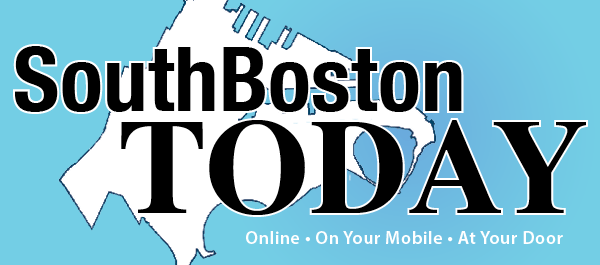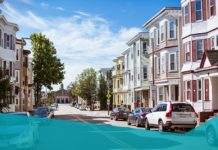(In Memoriam)
By Brian Mahoney
The second of a 3-part series on the History of Evacuation Day
The British conducted their last and most destructive raid into South Boston (Dorchester Neck) on February 13, 1776, burning houses and property of the Blake, Wiswell and Foster families among others. This time however, the Americans responded with 300 mounted troops, causing the British to flee in their longboats. It was this raid which seems to have been the final straw. Washington had been advocating for a frontal assault across the ice from Cambridge and Roxbury. His military council disagreed and after his final council of war on February 26, Washington wrote, “I am preparing to take a position on Dorchester Heights to see if the enemy will come out to meet me.” He had reversed course and decided the Americans would fight from fortified positions and force the British to make the frontal assault.
On the morning of March 2, the Americans opened a three-day bombardment of the British in Boston. Under an advance protective screen of 800 infantry, 2,000 artillery men began their stealthy advance into South Boston. With muffled horses’ hooves and wagon wheels, this column began to snake its way up the “Turnpike” (Dorchester Street). Reaching the area of today’s “Telegraph Street”, nine cannons for three artillery batteries were muscled up to the peak of the “Twin Hill.”
The column continued up the “Turnpike” until it reached today’s Perkins Square area. There, a sloping hill began to rise, extending west toward the West Broadway parking lot and north toward Dorchester Street and Emerson Street. This hill was known as “Leek’s Hill” and was designated for 7 cannons. Emerson Street, the second of South Boston’s original remaining streets, was called the “way to the Castle” and extended all the way to the east shore (Farragut Road). The column moved on this road to roughly “M” & East Fourth Street. At this point, six cannons were dragged up to “Bush Tree Hill” where their muzzles towered menacingly over the British warships at anchor. The last leg of the eastern march ended at Dorchester Point where a single three-gun battery was placed.
Back at “Leek’s Hill”, 700 men and 10 cannons skirted the western base and followed “Plaski Ave.” to West Third Street. This third and final road was known as the “Way to the Nook.” This road reached, straight as an arrow, to the 125 foot high “Nook Hill” located at today’s “B” & West Third Street. This hill was closest to British positions and warship anchorage so presented the most danger to the British. At the same time, its nearness made it the most exposed to British fire. It was decided by the Americans to fortify this hill last.
The cannon’s movement and the actual construction of their fortifications was a master stroke itself. Besides wrapping hooves and wheels in rags to muffle sounds, the Americans took a number of pre-emptive measures that led directly to victory.
The crossing into the “Neck” would have been under the eyes and guns of the British, particularly the “Green” artillery position located on a rise at today’s Berkeley and Washington Streets intersection. The American created a “Blind” or a wall that would cover their movements by twisting and weaving hay. This was called “Screwed Straw”. Washington, for weeks, had his troops out in the “Wilderness” of Dorchester collecting thin tree branches and kindling. This was used to build “Fascine” or walls around cannon positions; usually by digging a trench and combing dirt and branches to make those protective walls. The frozen ground plus the need for secrecy made digging impossible. The solution was called, “chandelier”. These were simply 10 by 4 foot skeletal wooden tubs. Light, mobile, easily moved into position around the cannons, filled with the “Fascines” and immediately turned into sturdy defensive walls.
During the next three days, the men labored to erect defenses while the non-stop bombardment of Boston provided cover their actions. A bombardment so fierce that famed jurist, Oliver Wendell Holmes, later wrote and spoke of it in a childhood memory. As a Boston schoolboy in the 1850’s, Homes recalled passing everyday by a house which still has “cannonball embedded in its chimney since that barrage”.
Over the centuries, Americans have been stirred to the defense of their country, in part by words identifying their cause. “Remember 911” is most recent. Before that it was “Remember Pearl Harbor”. Earlier, “Remember the Maine”. Still earlier, “Remember the Alamo”. It was on the “Heights” that call to battle was first used as General Washington walked among the troops exhorting them to “Remember the Men of March the Fifth”. Speaking of course, of the “Boston Massacre” six years earlier.
Upon awakening on March 5, 1776, General Howe first noticed the silenced cannons. Next, across the harbor, was the astonishing sight of the “Heights” bristling with troops and cannon from four positions. He then made his famous statement, “These men have done more work in a night than mine could do in a month.” Undeterred, Howe immediately drew up plans to attack across the harbor and dislodge the Americans from the Heights. All day, Boston was the scene of increasing alarm as British troops hustled about preparing for battle. Longboats were brought from the warships to ferry the troops for the assault and tied up at “Long Wharf”. By late afternoon, 2,400 troops were lined up at the foot of “Long Wharf”, today’s Purchase Street.
Stay tuned next week for the final chapter.
In the meantime, please remember public drinking is illegal.
A number of “Family Zones” have been created throughout the parade route and will be listed today and next week. Please ask your guests to respect the celebration, the town, and themselves and refrain from “Mardi Gras” type actions. Folks have worked diligently for a year to provide a safe, fun day that can be enjoyed by all.
Take care till next week.











